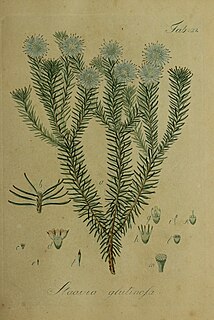
Charles Gaudichaud-Beaupré was a French botanist.

Joseph Marie Henry Alfred Perrier de la Bâthie was a French botanist who specialized in the plants of Madagascar.

Harry Bolus was a South African botanist, botanical artist, businessman and philanthropist. He advanced botany in South Africa by establishing bursaries, founding the Bolus Herbarium and bequeathing his library and a large part of his fortune to the South African College. Active in scientific circles, he was a Fellow of the Linnean Society, member and president of the South African Philosophical Society, the SA Medal and Grant by the SA Association for the Advancement of Science and an honorary D.Sc. from the University of the Cape of Good Hope.

Bolusanthus speciosus is a species of flowering plants in the family Fabaceae. It belongs to the subfamily Faboideae. It is the only member of the genus Bolusanthus.
Hilliardia is a monotypic genus of South African flowering plants in the daisy family. It only contains one known species, Hilliardia zuurbergensis(Oliv.) B.Nord.
Polemannia is a genus of flowering plants belonging to the family Apiaceae.

Neohenricia is a genus of flowering plants in the family Aizoaceae, native to South Africa. Low-lying succulents, they are found in places that can collect a little water, such as crevices and pans, on sandstone or dolorite, in areas that get at least 200 mm of rainfall annually.
Hammeria is a genus of flowering plants belonging to the family Aizoaceae.
Jacobsenia is a genus of flowering plants belonging to the family Aizoaceae.
Leipoldtia is a genus of flowering plants belonging to the family Aizoaceae.
Mossia is a monotypic genus of flowering plants belonging to the family Aizoaceae. It only contains one known species, Mossia intervallaris(L.Bolus) N.E.Br.
Ottosonderia is a genus of flowering plants belonging to the family Aizoaceae.

Stoeberia is a genus of flowering plants belonging to the family Aizoaceae.
Stayneria is a genus of flowering plants belonging to the family Aizoaceae. It just contains one species, Stayneria neilii(L.Bolus) L.Bolus It is in the Subfamily of Ruschioideae and Tribe of Ruschieae.

Staavia is a genus of flowering plants belonging to the family Bruniaceae.

Schlechteranthus is a genus of flowering plants belonging to the family Aizoaceae.
Rabiea is a genus of flowering plants belonging to the family Aizoaceae.
Polemanniopsis is a genus of flowering plants belonging to the family Apiaceae.
Maclaudia is a monotypic genus of flowering plants belonging to the family Apocynaceae. It only contains one known species, Maclaudia felixii Venter & R.L.Verh.
Marlothistella is a genus of flowering plants belonging to the family Aizoaceae.







